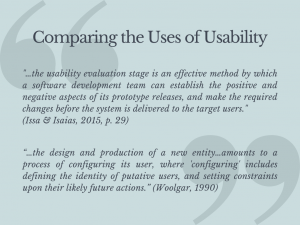Human Computer Interaction (HCI) is a field of research that combines computer and social sciences, engineering, and design. HCI is a concept in the system development process that focuses on understanding and creating software and other technology that people want to use, are able to use, and find effective when used. And the usability concept, and the methods and tools to encourage it, achieve it, and measure it are now touchstones in the culture of computing (Issa & Isaias, 2015, p. 19). Wikipedia (2022) defines usability as the capacity of a system to provide a condition for its users to perform tasks safely, effectively, and efficiently while enjoying the experience. Issa and Isaias (2015), further define usability, to include the quality of interaction, ease of use of a system, and the improvements related to use that can be made during the system design, as outlined in the figure below.
To further define usability from an educational perspective, usability should include the quality of interaction and ease of use of a system for both educators and learners. It should also include the improvements to use during the system design and should include feedback from not only the system design team, but educators and students who will be using the system. Further, considerations should be given to the usability of a system and how it helps educators and learners to achieve educational goals and improve the learning process. A system or technology can have all the features and functions programmed to maximize usability, but at the end of the day, if doesn’t align with an educator’s educational goals or improve the learning process for a learner, it will go unused. Finally, educational usability is not simply for user-technology/system interactions, educational systems have several interactions to consider including student-teacher, student-student, teacher-content, and student-content interactions (Gunesekera et al., 2019).
Woolgar’s (1990) account of usability gone wrong detailed several examples of how the design and production of a new computer resulted in and demonstrates the process of configuring the user. In one of the examples, Ruth, a tester of the system, attempts to plug in a printer. She is unable to do this because the computer socket is not compatible with the printer plug, making it impossible to complete the task. In another example, users were asked to test the text in the computer manuals. At the stage in the development of the computer, it was not fully known how the computer would fully function making the text being tested in the manual incomplete. It was perceived that if the manual failed, the “fault” was blamed on the user, not the computer. However, given the design of the computer had not been settled, it cannot be determined if either the computer or the user is at fault. In both examples, the failures could be explained by issues and challenges with the computer and the step in the design process, not the user or the functionality of the computer.

Issa and Isaias (2015) indicate the success, productivity, and efficiency of a system or technology includes involving the user to influence system design, integrating different knowledge and expertise in the design process, ensuring the design process is iterative, as well as, integrating usability evaluation. They achieve this by detailing specific usability criteria, which includes learnability, flexibility, robustness, efficiency, memorability, errors, and satisfaction (Issa & Isaias, 2015). These criteria help the developers create the best, most sellable product. In addition to usability, Issa and Isaias (2015) also factor in utility. This functionality ensures that users can do what they want the technology to do and does what users need the technology to do.
Woolgar (1990) indicates that the design and production of a new system or technology gives the design team the ability to shape or arrange the user so that they can complete a designated task. He also argues that having a concept of usability and detailed evaluation criteria will present valid research/test results. Lastly, he argues that the technology and the user should be held accountable for failed usability.
References
Gunesekera, A. I., Bao, Y., & Kibelloh, M. (2019). The role of usability on e-learning user interactions and satisfaction: A literature review. Journal of Systems and Information Technology, 21(3), 368-394. https://doi.org/10.1108/JSIT-02-2019-0024
Issa T. & Isaias P. (2015) Usability and Human Computer Interaction (HCI). Sustainable Design. London: Springer. https://doi-org.ezproxy.library.ubc.ca/10.1007/978-1-4471-6753-2_2
Wikipedia. (2022, May 7). Usability. Wikipedia. https://en.wikipedia.org/wiki/Usability
Woolgar, S. (1990). Configuring the user: the case of usability trials. The Sociological Review, 38 (1_suppl), 58-99. https://doi.org/10.1111/j.1467-954X.1990.tb03349.x
